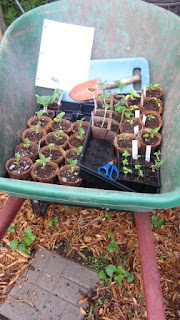Normally you would wait to transplant eggplants into the garden until soil & air temperatures are consistently in the 70’s. For peppers you hold off until the soil is 65 degrees F.
 |
| Wheelbarrow with all supplies for planting |
 |
| Laying out plants with Square Foot Gardening Method (SFGM) for spacing |
 |
| Cucumbers (to grow up trellis) with Eggplants in front |
Below is a picture of the actual layout of Bed #4 and then beside it is the plan we drew up this winter using the SFGM spacing.
 |
| Plan for BED #4 using SFGM |
 |
| Bed #4 ready to plant |
(16) Peas (after peas replant spaces)* with (8) Cucumbers
(12) Black Beauty Eggplant
(4) Red Bell Pepper
(4) Sweet Pepper
(2) Dark Star Zucchini
*This is the first year we have attempted to use succession planting (using efficient use of timing by planting a cool season spring crop followed by a heat-loving summer crop). Unfortunately the timing didn't work out completely. The peas were planted on March 17th but we had snow and because of that the peas took longer than expected to start growing.
Next year we are going to have to start the peas earlier so that they have produced before we need to do the next planting. I ended up just pulling out the peas in this bed (this bed only had 4 plants) so I could plant the cucumbers in their place.
 |
| Pepper plant |
 |
| Transplanted seedlings |
 |
| Row Cover with Garden Quilt Fabric |

No comments:
Post a Comment